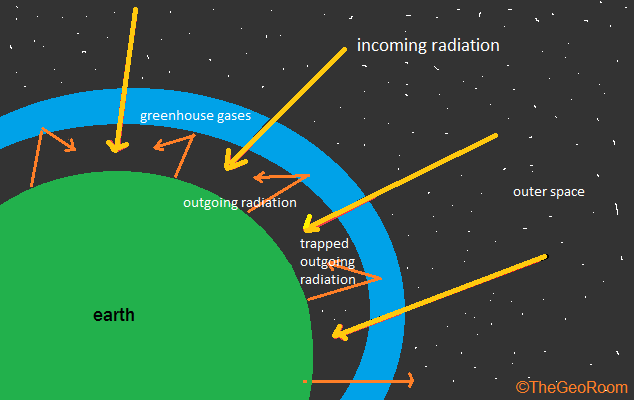The greenhouse is a layer of gases in the atmosphere mainly carbon dioxide, water vapour ,nitrogen, nitrogen and chlorofluorocarbons(CFCs) encircling the earth that traps the outgoing solar radiation.
The greenhouse gases allow incoming radiation to pass through but blocks and traps the outgoing terrestrial radiation.
The greenhouse effect helps to warm the earth but increasing amounts of greenhouse gas emission is resulting in more and more outgoing radiation being trapped intensely heating up the earth a phenomenon called global warming.

Where do the gases come from?
The majority of greenhouse gas emission comes from human activities. Since the industrial revolution CO2 amounts in the atmosphere has risen drastically. Carbon dioxide continue increasing at a rate of 0.4%-0.5% each year. Activities such as the burning of fossil fuels has significantly increased carbon dioxide amounts in the atmosphere.
Deforestation
Deforestation both commercial and non commercial causes abundant carbon dioxide to be left unabsorbed in the atmosphere. Other emissions of carbon dioxide comes from vehicles. Methane which comes mainly from cattle dung, anaerobic processes such as paddy fields and dumped waste has a significant contribution to the greenhouse.
Nitrous oxide which comes from fertilizer manufacturing and rocket launches also has a percent contribution to the greenhouse. Chlorofluorocarbons (C-chlorine, F-flourine,C-carbon) which mainly comes from refrigerants ,plastic products and aerosols contribute and enhances the greenhouse even more.
Volcanic Eruption
Some of the gas emissions are attributed to natural factors such as volcanic eruptions eg Mt Pinatubo Philippines, Mt Tambora(1815) and wild fires.
Effects
The most noticeable effect imposed by global warming is the melting of ice caps and sheets. Of particular concern are the poles which have experienced a drastic drop in ice cover eg Antarctica and Greenland.
Coastal Flooding
The result of melting ice caps and expansion of oceans causes sea levels to rise which in turn leads to floods especially in coastal areas. Sea levels are rising at a rate of 3.19mm per year this could cause low lying coastal areas to completely dissapear.
Melting Ice
The melting ice caps has also posed a threat to animal species such as polar bears. Melting ice caps has also posed a threat to countries relying on melt water.
Impact on Food Surplus
Increased warming of the globe has also lead to intense drying of already dried up land rendering them infertile and invaluable for farming. This has a significant impact on food production. In addition, these areas could experience acute water shortages.
Tropical Storms
In contrast to drying up of land, intense heating of the earth’s ocean is resulting in heavy storms such as cyclones and hurricanes. These storms can also lead to flooding which pose major damage.
Wild Fires
The intense heat is also causing incidences such as wild and brush fires.These are natural fires which can be ignited by lava, lightning or even a cigar drop. Furthermore, the intense heating of the globe has not only affected the earth but human healthy too.
Diseases
Exposure to high amounts of heat causes skin diseases such as cancer. People living with albinism are the worst affected. People are being affected by heat waves and sunstocks. In addition, photochemical smog which is a toxic mixture of particulates and sunlight increases under great heat. This has caused chronic diseases such as heart failures and respiratory problems.
Responses and Mitigation
While humans are the most polluters, they are the ones who can combat the increased warming of the globe. Several countries especially MEDCs have started substituting clean sources of energy such as solar and wind. Such energy sources does not emmit any harmfull gases into the atmosphere compared to fossil fuels such as coal.
Reforestation and Afforestation
Reforestation and Afforestation projects have assisted in absorbing huge ammounts of carbon dioxide. Some of these projects include the Kwimbare reforestation project where 6.4 million trees have been planted during a nine year period.
Japan did a major reforestaion project between 1950 and 1970 after WW2 where most trees had been destroyed(source Global Warming and Climate change, causes, impacts and mitigation Reearchgate).
Some mitigation and preventative measures include:
- Carbon sequestration which involves the piping and storing of CO2 underground usually on porous and permeable rocks.
- De-carbonization using ammonia
- Using zeolites to absorb and trap carbon dioxide molecules leaving relatively clean a gas.
- Catalytic converters on cars which separates nitric acids into nitrogen and oxide
- Reducing firewood and biomass burning
- Improving agricultural practices e.g reducing fertilizer usage
- Improving land distribution and standards of living especially in LEDCs
- Introducing new technologies which address or reduce gas emissions e.g electric vehicles and trains
- Introducing Carbon tax
- Providing incentives for using clean sources of energy and environmentally friendly practices
The increase of greenhouse gas emission resulted in the initiation of the Kyoto Protocol .The Kyoto protocol was formed in 1992 under a ten year period but was finalized in 1997 and signed by mostly developed countries except the USA. By 2008 almost 200 countries had signed in. The USA needed the involvement and targets be set for less developed countries in the protocol since they will likely be major polluters in the future. The Kyoto protocol strived to reduce greenhouse gas emissions by 5% against the gas level which were present at that year which it was formed. The European Union has managed to reduce its GHG emission by 5%. The Kyoto protocol was amended by the Doho which runs from 2013 to 2020 where 18% of GHG emission is to be reduced.

